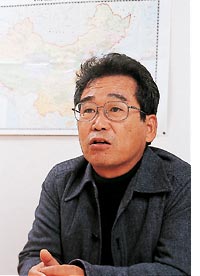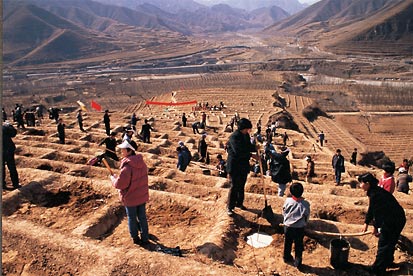|
|
||||||||||||||||||||||||||||||||
Special Feature*
Left: Takami Kunio says his biggest worry is that brush fires could spread and burn mature trees.
Right: A crowd of local people planting trees on the Loess Plateau. Using trees to push back the desert on the Loess Plateau
The Green Earth Network
Environmental degradation is severe on the Loess Plateau in China. The desert keeps growing, there are frequent droughts, and wells are going dry. When it does rain, the soil is washed away because the land is denuded of greenery. The Green Earth Network (GEN) is a Japanese non-governmental organization cooperating with people in China to bring trees back to the northeastern part of the plateau, near Datong in Shanxi Province. Takami Kunio, the head of the GEN secretariat, was concerned about environmental degradation in China and began volunteering his efforts with others in 1992.
GEN volunteers plant trees on mountains and hilly land (mainly pines because they can do well in infertile soil and dry conditions), and have planted orchards for about 50 elementary schools. So far, 13 million trees have been planted on 3,800 hectares of land. About 250 Japanese go there every year to plant trees with the local people.
Takami says, "Pine saplings don't do well before their roots spread out. It takes them three or four years to grow to a height of 30 cm, and they may die in a drought. But after five years, the ones that survive grow at least 30 cm a year, and they become a healthy, dark green. It will take quite a few years, even several decades, before tree planting there achieves good results."
Now, the group is planning to offer training and improve silviculture techniques, looking ahead to when the new forest can regenerate itself.
Getting city dwellers involved in mountain forests
The Acorn Bank
|
||||||||||||||||||||||||||||||||


